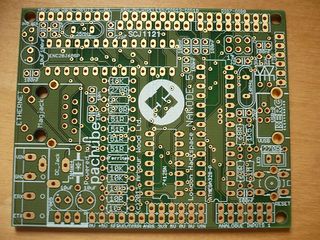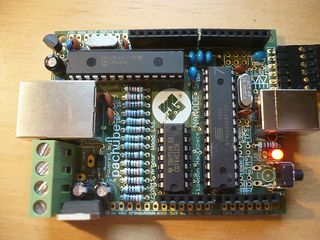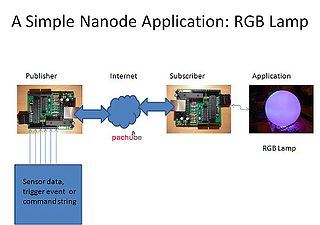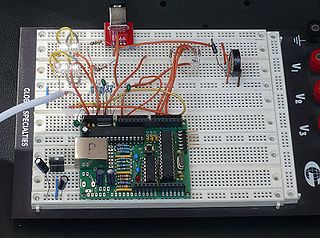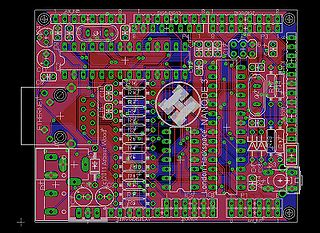Project:Nanode
London Hackspace - Home of the 'Nanode Project'
A collaborative venture in open source hardware and firmware.
The Nanode homepage is at nanode.eu.
About Nanode
Nanode - a 30 second pitch
Nanode is an open source Arduino-like board that has in-built web connectivity. It connects to a range of wireless, wired and ethernet interfaces.
It allows you to develop web based sensor and control systems - giving you web access to six analogue sensor lines and six digital I/O lines.
It costs under £20 as an easy build it yourself kit. Nanode was designed with Hacking in mind.
Some Background
The Nanode is a low cost entry device aimed at network and Internet Connectivity projects.
It's name was originally derived from "Networked Arduino Node" as it essentially opens up the possibility of networking Arduino-like devices both to the internet, and locally using a mix of wired and wireless networks.
It has been conceived as an experimental platform, an enabling technology, which will allow applications to be developed at minimum cost and hassle.
It combines the functionality of the Arduino and an ethernet shield onto the one small board. This literally halves the cost of a net connected Arduino platform.
It has been designed with low cost hacking in mind and can be built easily for under £20 - so that it will appeal to those on a tight budget.
It uses the popular Arduino environment so will be familiar to many. It also accepts Arduino shields, and a wireless shield based on the popular RFM12 device is planned. This will open up the Nanode to wireless networking and creating bridges between wireless, and wired networks and the Internet.
Nanode consists of a small PCB which has the ATmega328 microcontroller, some glue logic, the ENC28J60 ethernet controller and a Magjack ethernet connector. The board only uses through-hole and DIL conventional components - so that it can be easily assembled by anyone who has basic soldering skills.
It makes an ideal project for a teaching workshop on web connectivity, and as such will appeal to Hackspaces for advanced Arduino workshops.
Nanode Applications
Nanode uses a Ethernet code library developed by Andrew Lindsay. Andrew has provided examples for a Twitter Client (using supertweet.net), a Pachube Publisher and Pachube Subscriber. Andrew has also developed code to allow DNS Client queries and sending UDP packet to a local network.
Nanode can be used as a micro web-server for simple home automation and control, be used to build web connected sensor networks and many other web connected applications.
For those wanting to tinker with M2M applications, two Nanodes can communicate data or commands via a web data service such as Pachube.
Another unique feature is that several Nanodes can be connected together on a multidrop serial bus and used for distributed control tasks, such as energy montoring or home automation.
The wired network supplies communications and power and can be made from low cost 4 core telephone cable. 12V power can be distributed around this network and used to drive relays and actuators such as door locks.
Nanode provides between 10 and 12 input/output lines of which 6 can be analogue inputs for sensors such as thermistors or used for voltage and current measurement. Three of the outputs can be used for PWM control of motors, RGB lamps etc. Radio control servos are easily interfaced to the Nanode.
Individual Nanodes can communicate via this network back to an ethernet connected "Master" unit. With RS485 driver ICs, the Nanode can be adapted as a DMX lighting controller, MIDI network or other serial control system.
Nanode features an extra row of I/O pins - compared to the standard Arduino. This row of pins can be plugged directly into a breadboard and brings all of the ATmega I/O pins and power onto the breadboard. This greatly simplifies prototyping new applications on breadboard.
By removing the ethernet controller and Magjack, it becomes a very low cost Arduino "work-alike".
Nanode was inspired by the work of several key contributors.
Tuxgraphics - who wrote the original ENC28J60 code library
JeeNodes - for all things small and node like and routines for the RFM12 wireless
Ciseco - for the idea of stringing nodes together with a simple protocol
And many others, whose work has contributed to this project.
Nanode is an Open Source Project.
Open Source Collaborative Projects
The Nanode is possibly the first open source collaborative hardware design project at the London Hackspace- conceived, designed, manufactured and coded by Hackspace members - for Hackspace members. As an exercise in the design and building of a simple but useful microcontroller product, Nanode will introduce minimum cost web connectivity.
London Hackspace Custom Nanode
Here's a first draft of the proposed custom Nanode for the Hackspace. The Big H logo is a bit wonky, but we should be able to correct that with a bitmap import. Roger Light is working on this and other minor layout tweaks.
This new board offers several improvements over the first prototype.
The reset switch is vertically mounted on the edge of the board - so it can be pressed even though there may be a shield fitted.
The LED - again on the board edge, is visible with a shield fitted.
The local serial bus is now a 4 way screw terminal block for very easy hooking up with 4 way telephone cable which supplies 12V power and the Rx/Tx and ground lines. Remote nodes could draw up to 500mA total at 12V for powering actuators, motors etc.
Auto reset now added from serial interface - this uses Pin 6 of the FTDI cable and works with Arduino IDE.
Virtual USB Added. Vusb USB is done in firmware negating the need for a £15 FTDI cable. We then use the same programming tool as Metaboard uses - cool.
How to Build a Nanode
Building a Nanode
The complete step by step build sequence is here Building a Nanode.
An older version for a previous design can be found on my blog
Parts List
This section needs updating to reflect the changes in Nanode 5 over the earlier prototype.
All parts are readily available. I recommend Cool Components in South London for several of the key items. Interested parties should try to pool component purchasing to access volume discounts.
* 1 ATmega328 microcontroller (with Arduino bootloader) - CoolComponents £5.00 (£2.81 without bootloader) * 1 ENC28J60 ethernet controller - CoolComponents 1.99 * 1 Magjack - CoolComponents £1.99
The remaining parts were found to be considerably cheaper from Rapid Electronics giving a kit cost of £18 if parts are purchased in 10 off. This includes all parts, pcb, shipping and VAT.
* 1 74AHC125 quad buffer 174-9617 * 1 16MHz crystal 161-1761 * 1 25MHz crystal 161-1783 * 4 22pF ceramic capacitors 114-1760 * 8 100nF ceramic capacitors 121-6444 * 2 10nF ceramic capacitors 121-6435 * 3 10uF electrolytic capacitors 945-1056 * 1 7805 5V regulator 156-4483 * 1 78L33 3V3 regulator 146-7768 * 1 2K resistor 934-1480 * 4 51ohm 1% resistors 934-3342 * 3 270 ohm resistors 933-9353 * 3 10K resistors 933-9060 * 1 tact switch 181-3689 * 2 8 way 0.1" SIL Sockets * 2 6 way 0.1" SIL Sockets * 1 6 way 0.1" right angle header * 1 2.1mm dc jack socket * 1 1N4001 diode * 1 3mm LED * 2 32 pin 0.1" header strips (for optional I/O connectors).
You will also need:
* 1 Nanode pcb - available shortly to Hackspace members * 1 FTDI USB-serial cable - becoming a standard bit of kit for talking to microcontrollers. * or similar USB to serial converter such as Sparkfun/Cool Components * 1 CAT5 network cable to connect to router
Board Layout and Connectors
The nanode is, in essence, an arduino, with a hardwired ethernet chip, and several extra connectors / footprints for other useful bits and bobs.
The USB connector is on arduino D4 = USB D- and arduino D5 = USB D+, with zenier diode overvoltage protection and pull up / pull down and protection resistors to mostly conform to the USB spec.
The other peripherals are connected through an SPI bus, which implies that each of them has an enable pin on the microcontroller. Those pins are:
- IC2: ENC28J60SP - the ethernet controller. D8 is the enable pin. It also has an interrupt pin, on D2.
- IC7 (back centre): This is a landing for a Microchip 23k256 SPI RAM chip, or a large number of similar chips. D9 is it's enable pin.
Analogue 2 Connector
Pin Name
- +5V
- Analog Input 5
- Analog Input 4
- Analog Input 3
- Analog Input 2
- Analog Input 1
- Analog Input 0
- OV
Wireless& SPI Connector
Pin Name
- +5V
- 0V
- SCK
- MISO
- MOSI
- SS
- INT
- 3V3
Digital 7- 0 Connector
Pin Name
- Digital 7
- Digital 6
- Digital 5
- Digital 4
- Digital 3
- Digital 2
- Digital 1
- Digital 0
Current Build Files
The latest Nanode 5 build files have been put up on Thingiverse .
Earlier versions on Thingiverse are really for reference only and should not be treated as current. The following data relating to versions 2 and 3 is for information or historical reference only:
The first prototype Nanode 2j had a couple of minor layout bugs, these have been corrected in 2l. The EagleCAD pcb files have been uploaded to Thingiverse as a starting point, but potential users should read the bug-list on the schematic page.
I've now corrected the pcb errors and made some improvements. The Version 3d files are here on Thingiverse
1. Fixed the incorrect connections on the Magjack
2. Moved the reset switch to edge of board and allow for a vertical switch which can be pressed even if shield is fitted.
3. Moved the LED to board edge so that you can see it
4. The local comms bus and power now routed to a 4 pin screw terminal for easier connection
5. Added auto reset capacitor C17 on pin 6 of FTDI connector
6. Added pull-up resistor to /RXEN so that it defaults to FTDI connection
7. Removed surplus connectors
8. Added a H as a place keeper for the proper Hackspace Logo
9. Added text "London Hackspace NANODE 3" and Arbour Wood (c)2011 (My Firm).
10. Improved position of 3V3 decoupling capacitors on ENC28J60
11. Analogue input connector J12 now has GND pin
12. Implemented Virtual USB with connector P7 on end of the pcb - saving cost of FTDI cable!!
14. I think that these would be so cool on blue pcb board with white Hackspace "H" Logo
Example Applications
Nanode Applications
Now moved to the Nanode Applications page.
Projects "In the Wild"
- Nanode controlled RGB LED Lamp, with simple serial command interpreter - see my blog here.
- 6 channel temperature monitoring using Pachube - email Ken via LHS list for code.
Add links to your own projects...
Brainstorming
This section is for all potential applications and wild ideas of what can be done with the Nanode.
Some other ideas planned or on the wish list: - please feel free to add your own ideas/wishes. If you want to contribute to any of these ideas - go ahead!
1. A low cost, plug-in wireless shield using popular RFM12 wireless module would allow the Nanode to form the basis of wireless networks - as well as have compatability with JeeNodes and some of the CurrentCost Energy Monitoring devices. I'm currently working on this shield layout - Ken
2. Use of virtual USB to eliminate the FTDI cable - implememted on Version 4. Hardware done on V3 and V4 - firmware & bootloader need to be tested.
3. A serial configuration program. Allows the IP address and other configuration parameters of the Nanode to be easily programmed from PC/MAC. Nanodes could be given unique MAC and sub-address. Sam Carlisle and Matt Gaffen worken on this at the Pachube Hackathon.
4. A position for a surface mount SPI memory (either RAM or EE) on the underside of the board to allow web page storage or much needed RAM buffer space. Microchip 23K256 adds 32K RAM for £1. One SMT device as an option should be acceptable to most constructors. Done - on V4, will also work with non-volatile FRAM memory. Provision on V4 for Microchip 11AA02EU48 - unique MAC address from tiny 3 pin chip. - Ken
5. An energy monitoring shield for electricity and gas meter pulse counting - working on this with Glyn Hudson and Trystan Lea of openenergymonitor.org. -Ken
6. Define a simple serial network protocol to allow Nanodes to communicate
7. Improved firmware to allow easy access to and from Pachube for data exchange
8. Firmware to allow MQTT messaging
9. Experiments to define maximum data transfer rates across the various networks
10. Dedicated web forum / wiki for all Nanode co-developers: http://nanode.eu
As a simple example, a Nanode could read up to 6 analogue sensors, connected to its ADC inputs - such as temperature sensing thermistors or LM35 thermometer ICs. These temperature sensors are located in different rooms of the house, or outside, or on the hot water tank. Between them they give an indication of the state of the home heating. The temperature readings are published up to a Pachube feed, where they can be accessed by other devices. A Nanode subscribing to the feed reads the temperature data as a CSV string, strips out the numerical data and acts on its content. For example controlling a user display, operating relays which control the boiler for heating or hot water as it is required.
The CSV format which Pachube uses is flexible enough to cope with many types of data, or even direct numerical commands. A string of comma separated, numerical commands passed up to Pachube could be simply interpreted by any subscribing Nanodes to perform a specific action. The first number could be the address of the Nanode which you want to command, for example the one which controls the boiler relay.
Openenergymonitor have developed some very low cost Arduino based devices to read electricity and gas meters. One of these will shortly be released as an Arduino shield and could use the Nanode as its connection to the net.
The other main application of the Nanode is in Master/Slave wired networks. Several Nanodes are connected to a wired serial bus and distributed about the environment where they run sensing or control tasks - such as a home automation system or DMX lighting control system. Each slave can be addressed individually by a Master controller, which then connects via its ethernet connection to the web.
Slaves could store sensor readings in RAM (limited to 2K on the '328) and periodically be polled by the Master device to connect to the serial bus and upload its data. Data could be recorded straight off the serial bus using the Openlog serial data logger concept from Sparkfun Electronics. The Openlog code runs nicely on an Arduino fitted with a SDcard shield, so could be run on the Master Nanode. The Master could act as a SDcard based file server or storage to the serially connected slaves.
Help and Further Documentation
Questions & Answers & Feedback
If you have any queries - please put them here under the relevant section heading.
HARDWARE
Update 12/5/11 Version 5 is the latest Hackspace Version - see above for list of changes.
PCBs expected at the end of May. A Nanode Build and Applications Weekend is planned for June 4th / 5th.
Update 15/4/11
Roger Light has ported the Hackspace Logo and is making minor tidying operations to the pcb tracking.
See Thingiverse for earlier board files.
Is the local bandwidth between two nanodes enough to create an ethernet bridge in software? -- Answer to myself: the multidrop bus is in the range of 9600 baud.
The ATmega328 is not limited to 9600 baud serial. If the distance between nodes is short then 115,200 baud may be possible. You could also connect nodes together with I2C or SPI over short distances. Ken
PCBS & KITS
Can non-members join the PCB batch?
Yes - but note that we are currently only offering a full kit consisting of pcb and all components for £18.00. The first batch of 40 should be available in early May. We will hold a weekend workshop "Nanode Build and Test" session to coincide with the kits arriving.
Bare boards may be available at a later date, but for now the £18 kit is the only option being offered. A small donation to the Hackspace from non-members would be appreciated. Ken
PROGRAMMING
Will the Vusb code fit in the bootloader to allow it's use for programming the board ?
By all accounts, adding Vusb will make the Nanode appear like a Metaboard - which can be programmed by adding their programmer to the toolsuite in the Arduino IDE. Programming should then be a case of picking the Metaboard option. Metaboard Ken
CODE EXAMPLES
There's a 'readpachube' example in Andrew's 1.6 software release, which I presume is the Pachube subscriber. I can't see a publisher though - is that available from somewhere else ?
I have developed a Pachube Publisher and matching Subscriber which allows serial CSV text strings to be sent from one Nanode to another via my Pachube Feeds 9675. If you put a request email to the Hackspace mailing list,I will send you the files. You will need to add your own Pachube API Key. I've more detail on my blog here. Ken
News
Moved to Project:Nanode/News.
